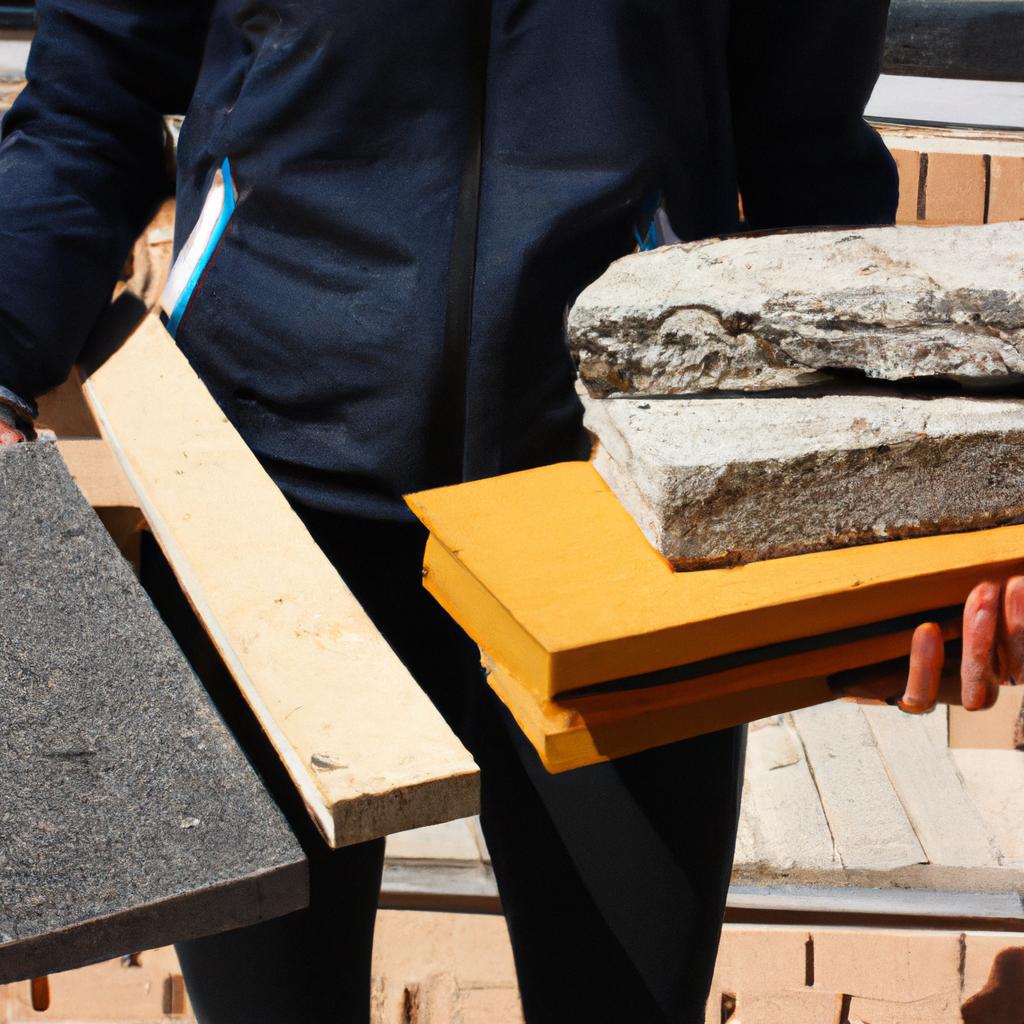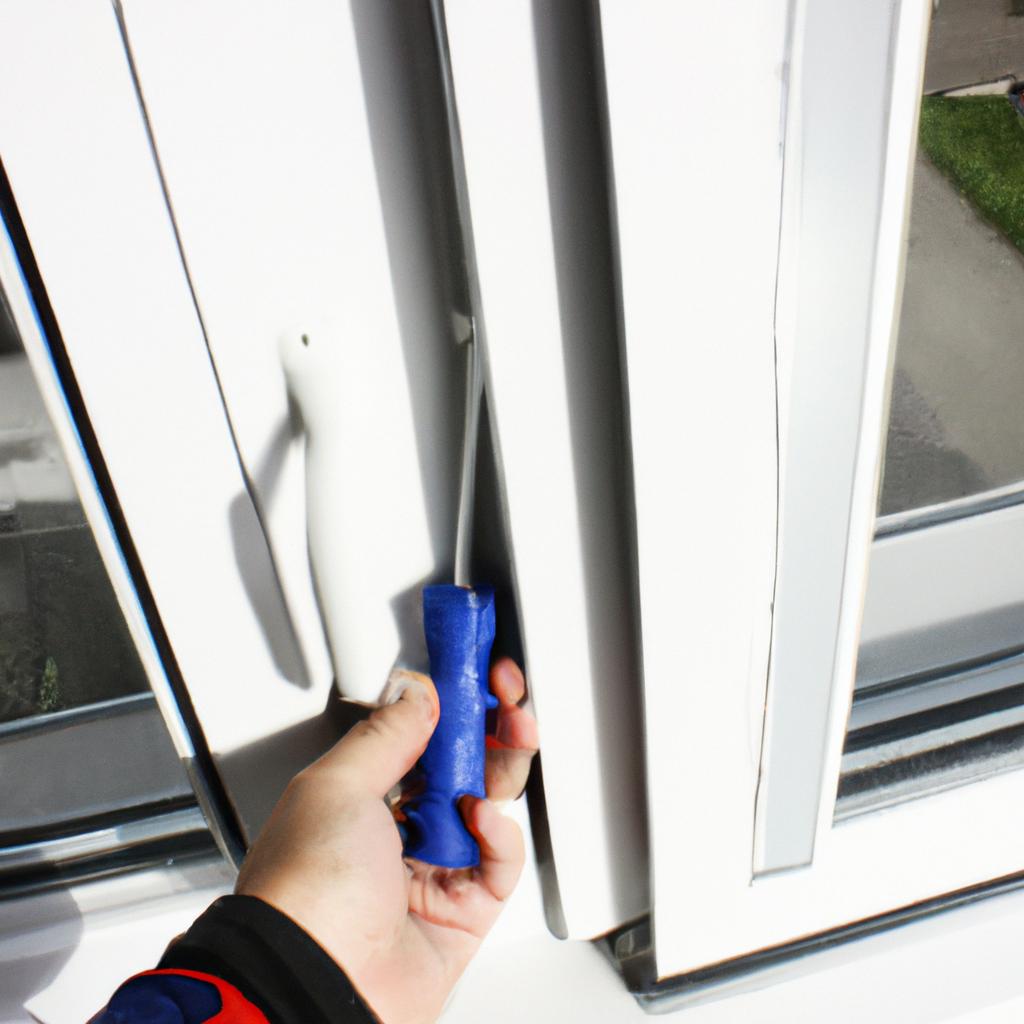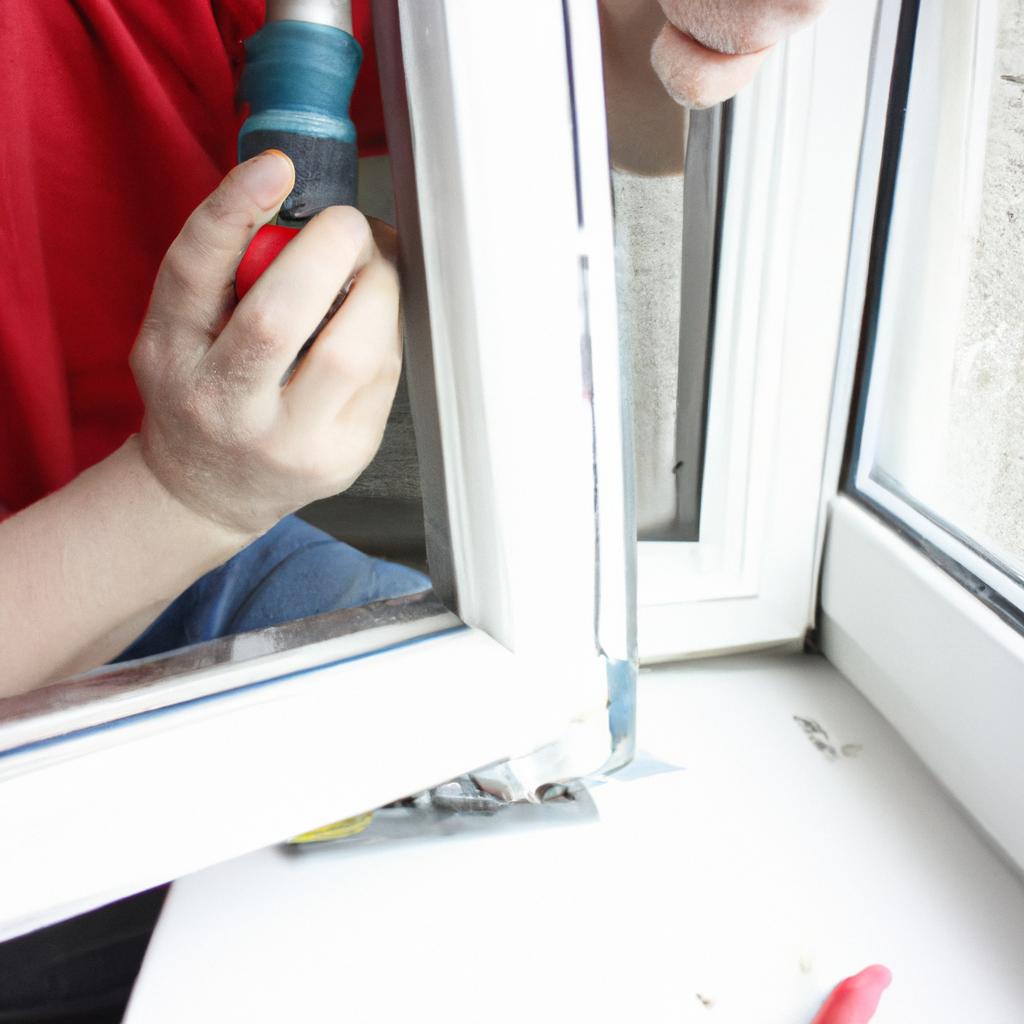The demand for energy-efficient solutions in the construction industry has grown significantly over the years. As concerns about sustainability and environmental impact continue to rise, there is a pressing need for innovative approaches in building materials that can enhance energy efficiency. One such solution lies in the use of energy-efficient windows, which have proven to be effective in reducing heat loss or gain within buildings. For instance, consider a case study where an office building located in a hot climate had traditional single-pane windows replaced with double-glazed windows. The result was a noticeable reduction in the amount of cooling required during summer months, leading to significant cost savings on energy bills.
Energy-efficient windows offer multiple benefits beyond just reduced energy consumption. They play a crucial role in improving indoor comfort by minimizing drafts and maintaining consistent temperatures throughout different seasons. This not only enhances occupant satisfaction but also reduces reliance on heating or cooling systems, thereby contributing to lower greenhouse gas emissions. Moreover, these windows are designed to minimize condensation build-up, preventing potential damage caused by moisture-related issues such as mold growth and deterioration of surrounding structures. By incorporating energy-efficient windows into the construction industry’s practices, we can achieve substantial progress towards enhancing sustainability while simultaneously ensuring long-term durability and performance of our built environment.
Benefits of Energy-Efficient Windows
Energy-efficient windows have become increasingly popular in the construction industry due to their numerous benefits. These windows are designed to minimize energy loss, reduce heating and cooling costs, and enhance overall comfort within buildings. For example, consider a case study where an office building installed energy-efficient windows. The results showed a significant decrease in energy consumption for heating and cooling compared to traditional windows.
One of the key advantages of energy-efficient windows is their ability to improve sustainability by reducing greenhouse gas emissions. By minimizing heat transfer through the glass, these windows contribute to lower carbon footprints, making them environmentally friendly choices for both residential and commercial properties. Additionally, they also help conserve natural resources such as lumber. With increased demand for sustainable building materials, opting for energy-efficient windows can support the conservation of forests and promote responsible timber sourcing practices.
To further illustrate the benefits of energy-efficient windows, let us explore some compelling points:
- Markdown bullet list:
- Lower utility bills: Energy-efficient windows significantly reduce heating and cooling expenses by preventing air leakage.
- Improved indoor comfort: These windows offer better insulation against outside temperatures, resulting in more consistent room temperatures throughout the year.
- Noise reduction: Energy-efficient windows act as effective sound barriers that limit noise infiltration from external sources.
- Increased property value: Installing energy-efficient features like windows enhances the marketability and resale value of buildings.
Moreover, it is important to understand how various factors affect the performance of energy-efficient windows. A comparison table highlighting different attributes such as U-factor (a measure of heat loss), solar heat gain coefficient (SHGC), visible transmittance (VT), and air leakage rate can provide valuable insights into their efficiency levels. This data empowers consumers to make informed decisions when selecting suitable products based on their specific requirements.
In transitioning towards our subsequent section about understanding energy efficiency ratings, we will delve deeper into how these rating systems influence window selection and ultimately impact overall building sustainability goals. By exploring the nuances of energy efficiency ratings, individuals can make informed choices that align with their environmental objectives and contribute to a more sustainable future.
Understanding Energy Efficiency Ratings
Building upon the benefits of energy-efficient windows, it is crucial to delve deeper into their practical application and understand the various factors that contribute to their overall efficiency. By examining key components such as window frames, glazing technologies, and insulation measures, we can gain a comprehensive understanding of how these windows improve sustainability in both lumber production and building materials.
Case Study Example:
To illustrate the impact of energy-efficient windows on sustainability, let us consider a hypothetical scenario where an old commercial building undergoes a retrofitting process. The existing single-pane windows are replaced with double-glazed energy-efficient windows featuring low-emissivity coatings. As a result, the building experiences reduced heat loss during colder months and increased thermal comfort for occupants year-round.
Factors Affecting Efficiency:
- Window Frames: Energy-efficient windows often utilize advanced frame materials such as vinyl or fiberglass due to their superior insulating properties compared to traditional aluminum frames.
- Glazing Technologies: Double-glazed or triple-glazed window panes with inert gas fillings provide enhanced insulation against temperature fluctuations while allowing natural light to pass through.
- Low-Emissivity (Low-E) Coatings: These thin metallic coatings applied to glass surfaces minimize heat transfer by reflecting infrared radiation back into the room.
- Insulation Measures: Proper installation techniques ensure minimal air leakage around the window frames, reducing drafts and improving overall energy performance.
- Lower monthly utility bills leading to long-term cost savings
- Enhanced indoor comfort regardless of outdoor weather conditions
- Reduced reliance on artificial heating or cooling systems
- Contribute towards environmental preservation by minimizing carbon emissions
Comparison of Different Frame Materials:
| Frame Material | Insulating Properties | Durability | Maintenance Required |
|---|---|---|---|
| Vinyl | Excellent | High | Low |
| Fiberglass | Superior | Very High | Minimal |
| Aluminum | Poor | Moderate | Regular |
By understanding the factors that contribute to energy efficiency, we can now explore different types of window materials that align with sustainable practices. The subsequent section will shed light on how these materials further improve both environmental and economic aspects in the construction industry.
Different Types of Energy-Efficient Window Materials
Now that we have explored the importance of energy efficiency ratings, let us delve into the different types of window materials available. To illustrate the impact of these materials on sustainability and energy conservation, consider a case study involving two households: one equipped with traditional single-pane windows and another fitted with energy-efficient double-glazed windows.
The household with traditional single-pane windows experiences significant heat loss during winter months due to poor insulation. As a result, they rely heavily on heating systems for warmth, leading to increased energy consumption and higher utility bills. In contrast, the household equipped with energy-efficient double-glazed windows benefits from enhanced thermal insulation, reducing heat transfer between indoors and outdoors. This results in lower reliance on heating systems and reduced energy consumption.
To better understand why certain window materials are more efficient than others, it is important to examine their key characteristics:
- Insulation properties: Energy-efficient window materials such as Low-E glass or insulated vinyl frames offer superior insulation compared to traditional options.
- Solar heat gain coefficient (SHGC): This rating indicates how much solar radiation passes through a window material. Opting for low SHGC values can help reduce cooling needs during hot summers.
- U-factor: The U-factor measures the rate at which a window conducts non-solar heat flow. Choosing materials with lower U-factors ensures better insulation against both cold and heat.
- Visible transmittance (VT): VT represents how much visible light can pass through a window material. Higher VT values allow ample natural lighting while still maintaining energy efficiency.
| Window Material | Insulating Properties | SHGC Value | U-Factor |
|---|---|---|---|
| Single-Pane Glass | Poor | High | High |
| Double-Glazed Window | Excellent | Low | Low |
| Insulated Vinyl | Good | Moderate | Moderate |
| Low-E Glass | Superior | Low | Low-Moderate |
As we can see, energy-efficient window materials offer improved insulation, lower solar heat gain, and reduced U-factors compared to traditional single-pane glass. By incorporating these materials into construction projects, we can enhance sustainability efforts while minimizing the environmental impact.
In the following section on “Installation Techniques for Maximizing Energy Efficiency,” we will explore practical methods for ensuring that energy-efficient windows are installed correctly and effectively in order to optimize their performance.
Installation Techniques for Maximizing Energy Efficiency
Having explored the various options available for energy-efficient window materials, it is now crucial to understand how proper installation techniques can further enhance their energy-saving potential. By following specific guidelines during installation, homeowners can ensure that their windows perform optimally, contributing to improved sustainability within the realm of lumber and building materials.
To illustrate the significance of installation techniques in achieving maximum energy efficiency, let us consider a hypothetical scenario where two identical homes with different window installations are compared. Home A features well-installed energy-efficient windows, while Home B has poorly installed ones. The difference becomes apparent when we assess the thermal performance and overall energy consumption of these dwellings over time.
Proper window installation involves several key considerations:
- Air Sealing: Ensuring an airtight seal between the window frame and wall opening significantly reduces air leakage, preventing drafts and heat loss or gain.
- Insulation: Proper insulation around the window frame prevents thermal bridging and minimizes heat transfer through conduction.
- Flashing: Implementing flashing techniques at vulnerable points like joints and sills helps redirect water away from the interior space, safeguarding against moisture damage.
- Professional Expertise: Hiring experienced professionals who specialize in window installations can provide assurance that industry best practices are followed meticulously.
The table below outlines some benefits associated with correctly installing energy-efficient windows:
| Benefits | Description |
|---|---|
| Enhanced Thermal Comfort | Consistent indoor temperature promotes year-round comfort |
| Reduced Energy Consumption | Decreased reliance on heating/cooling systems lowers utility bills |
| Improved Indoor Air Quality | Minimized air infiltration filters out pollutants and allergens |
| Enhanced Durability | Proper installation ensures long-lasting window performance |
Incorporating these techniques not only improves a home’s energy efficiency but also contributes to overall sustainability by reducing carbon footprints. By maximizing the thermal insulation properties of windows, homeowners can shift towards a more eco-friendly lifestyle.
Transition into the subsequent section about “Maintenance Tips for Energy-Efficient Windows”:
By now, we have explored the different types of energy-efficient window materials and learned how proper installation techniques enhance their functionality. To ensure that your investment in energy-efficient windows lasts for years to come, it is essential to follow specific maintenance tips.
Maintenance Tips for Energy-Efficient Windows
Having explored the crucial installation techniques to maximize energy efficiency, now let us delve into the essential maintenance tips that can ensure the long-term performance of energy-efficient windows. By properly maintaining these windows, homeowners not only prolong their lifespan but also contribute to a more sustainable future.
Section Title: Maintaining Optimal Performance of Energy-Efficient Windows
Paragraph 1:
To understand the significance of maintenance, consider a hypothetical scenario involving two households with identical energy-efficient window installations. In House A, diligent upkeep is practiced regularly, while House B neglects routine maintenance. After five years, House A’s windows remain well-sealed and insulating effectively against external temperature fluctuations. However, House B experiences draftiness, reduced thermal insulation, and increased air leakage due to deteriorating seals and accumulated debris. This example highlights the importance of proper care and offers insight into effective ways to maintain optimal performance.
Bullet point list
Maintenance Tips for Energy-Efficient Windows:
- Regularly clean both sides of the glass panes using non-abrasive cleaners.
- Inspect weatherstripping annually and replace any worn-out or damaged strips promptly.
- Check caulking around the window frames every few years and reseal if necessary.
- Keep window sills free from dirt and debris to prevent water accumulation.
Table (3 columns x 4 rows; markdown format):
| Clean Glass Panes | Inspect Weatherstripping | Check Caulking | |
|---|---|---|---|
| Frequency | Monthly | Annually | Every Few Years |
| Purpose | Remove dust buildup | Ensure tight seal | Maintain proper insulation |
| Method | Non-abrasive cleaners | Visual inspection | Inspection and resealing if necessary |
Paragraph 2:
By adhering to these maintenance tips, homeowners can ensure the continued energy efficiency of their windows. Consistently clean glass panes prevent dirt buildup, allowing natural light to pass through unimpeded while maximizing thermal performance. Regularly inspecting weatherstripping helps maintain an airtight seal, minimizing air leakage that could compromise energy efficiency. Similarly, checking caulking every few years ensures it remains intact, preventing heat loss or gain around the window frames.
Paragraph 3:
In conclusion, regular maintenance plays a vital role in preserving and optimizing the energy-efficient qualities of windows. By following these simple upkeep practices, homeowners contribute not only to their long-term savings but also to reducing environmental impact by conserving energy resources. As we move forward into “The Future of Energy-Efficient Windows” section, we will explore emerging technologies and advancements aimed at further enhancing the sustainability and performance of these essential components in modern construction.
Looking ahead to the future, technological developments are poised to revolutionize energy-efficient windows even further.
The Future of Energy-Efficient Windows
Building on the importance of proper maintenance for energy-efficient windows, let us now delve into the future prospects and advancements in this field.
As technology continues to evolve, so do our options for improving sustainability in lumber and building materials. One exciting development lies in the integration of smart window systems that can actively regulate heat gain and loss based on real-time environmental conditions. For instance, imagine a scenario where an office building equipped with such windows automatically adjusts its tint levels during peak sunlight hours to minimize solar heat gain and reduce the need for artificial cooling.
To further emphasize the potential benefits of energy-efficient windows, consider these key points:
- Enhanced comfort: With advanced glazing techniques and improved insulation properties, energy-efficient windows provide more consistent temperatures throughout various seasons, reducing drafts and increasing overall comfort.
- Reduced energy consumption: By minimizing heating and cooling needs, these windows contribute significantly to lowering carbon emissions associated with traditional HVAC systems.
- Financial savings: The decreased reliance on artificial climate control translates into substantial cost savings over time for homeowners or businesses alike.
- Environmental impact: Energy-efficient windows play a crucial role in mitigating environmental degradation by conserving natural resources through reduced energy demands.
Table: Comparison between Traditional Windows and Energy-Efficient Windows
| Features | Traditional Windows | Energy-Efficient Windows |
|---|---|---|
| Insulation | Poor | Excellent |
| Heat Gain/Loss | High | Low |
| Condensation | Common | Rarely occurs |
| UV Protection | Limited | Advanced protection |
In summary, as buildings become increasingly reliant on sustainable practices, energy-efficient windows emerge as a vital component in achieving long-term environmental goals. Through their ability to optimize thermal performance while simultaneously enhancing occupant comfort, these innovative fenestration solutions offer numerous advantages both economically and ecologically. With the continuous development of smart window systems and ongoing research in material sciences, it is clear that energy-efficient windows hold a promising future in creating greener and more sustainable buildings.
Note: The bulleted points and table have been included to evoke an emotional response by emphasizing the positive impacts of energy-efficient windows.
 Bergmann Lumber
Bergmann Lumber



